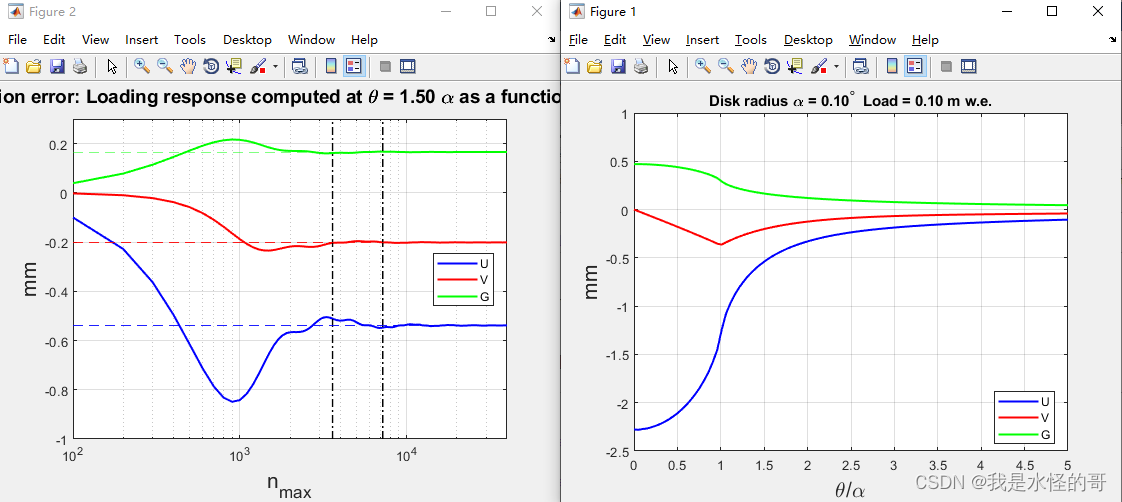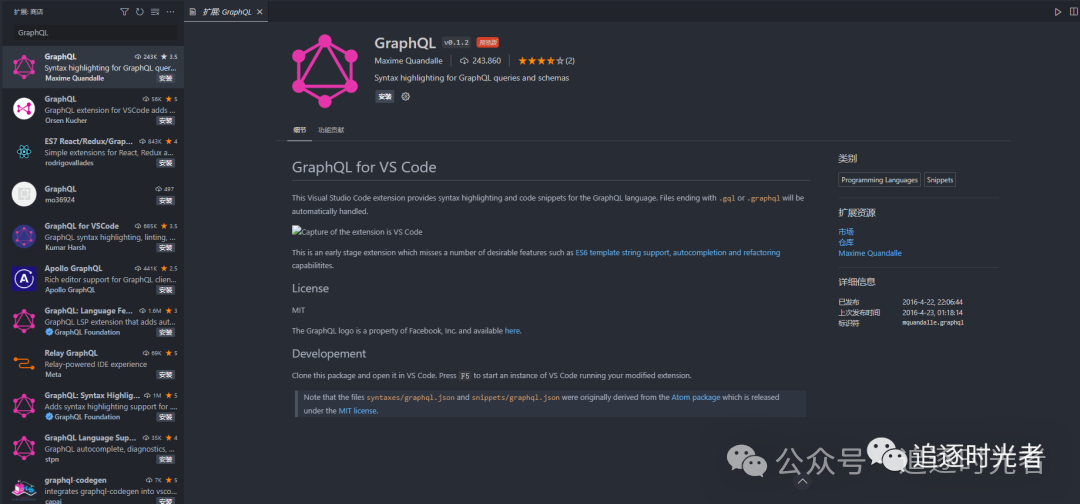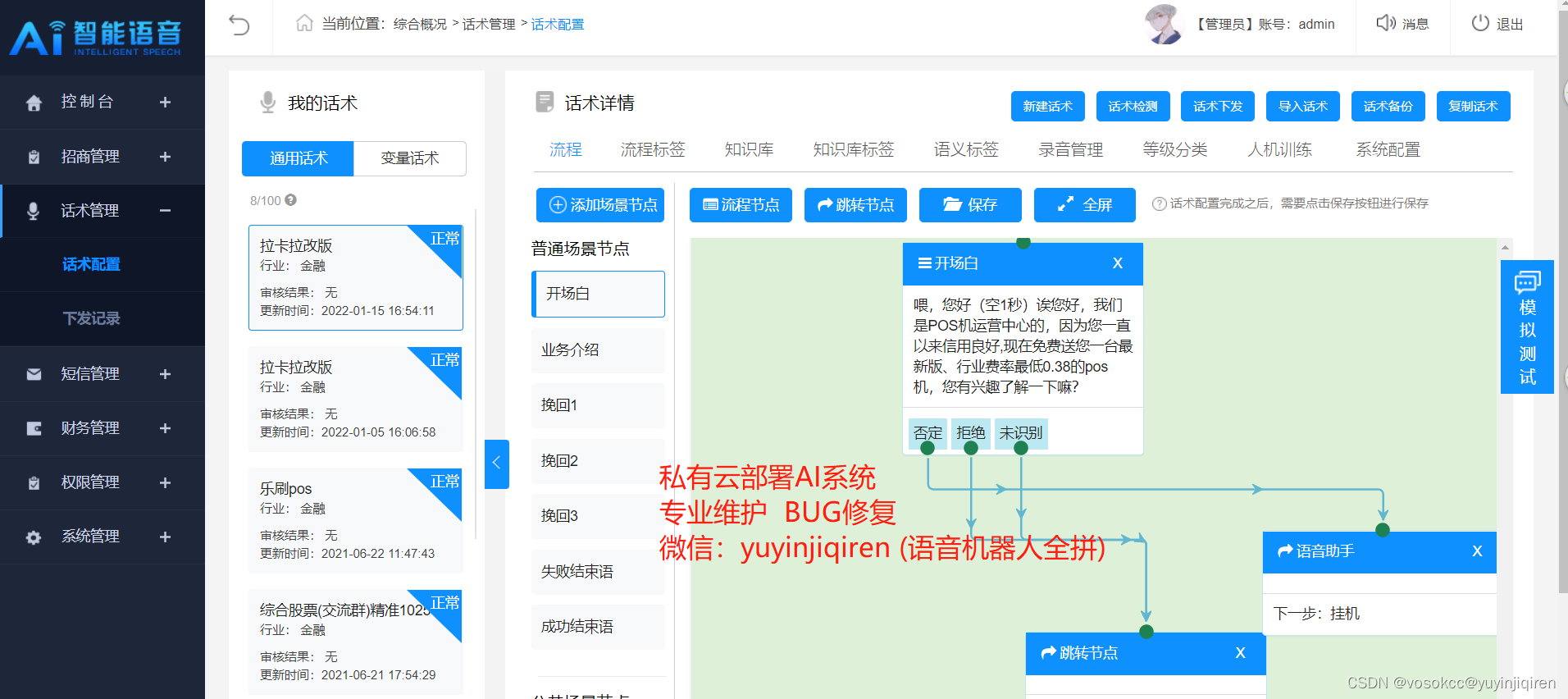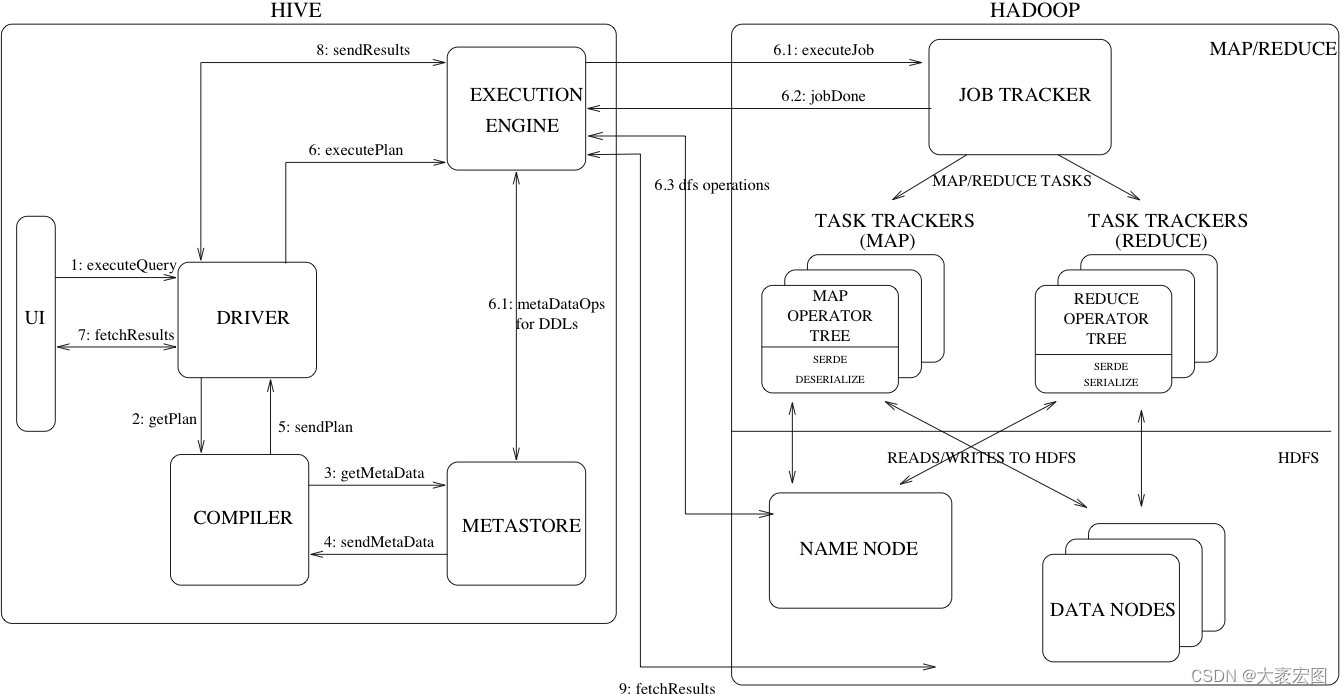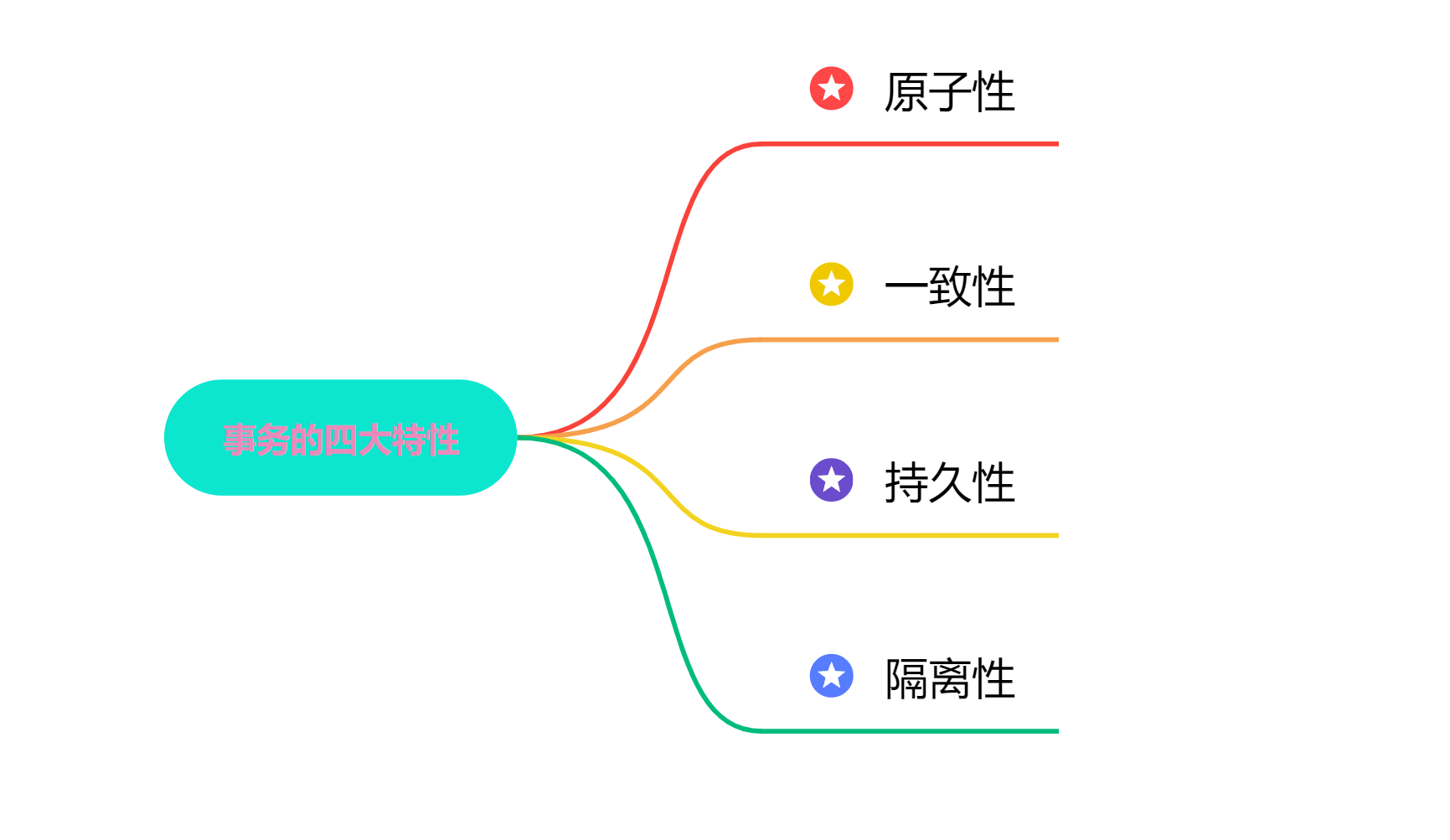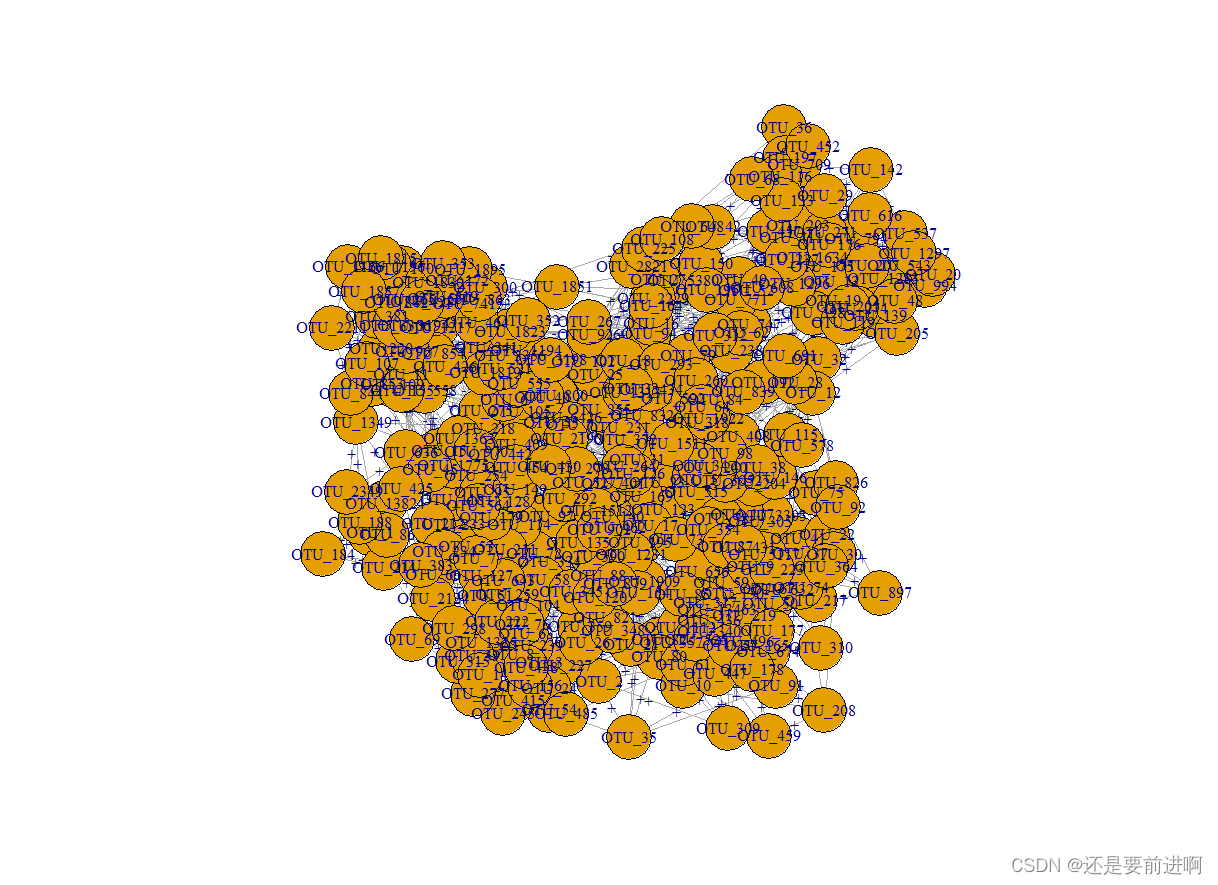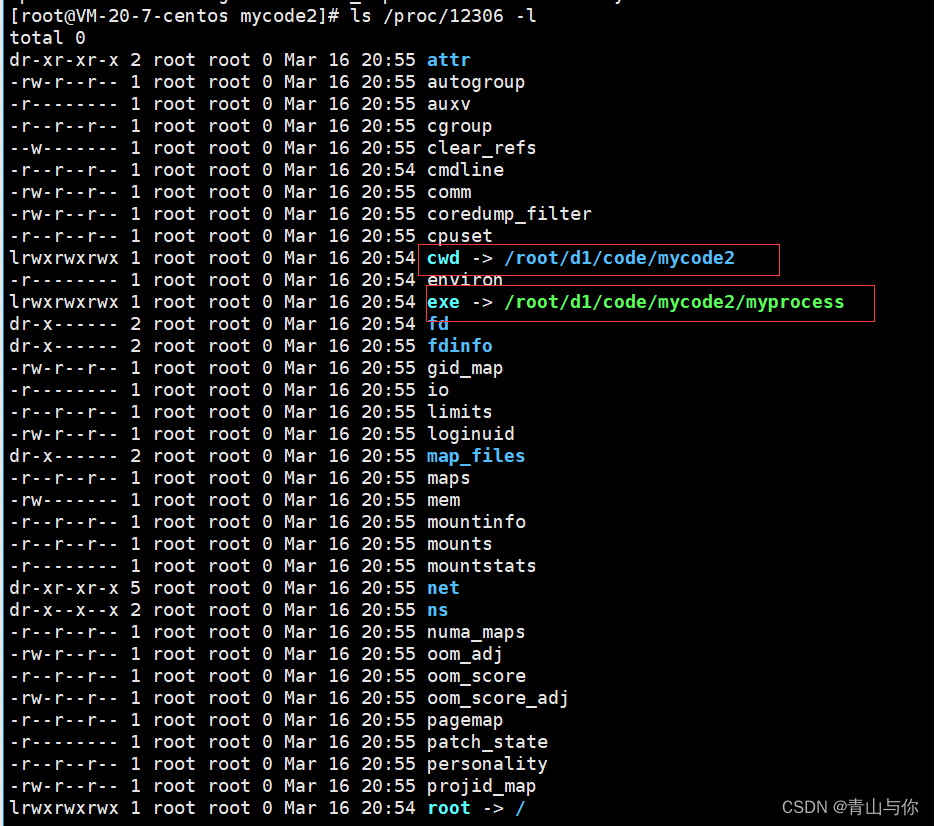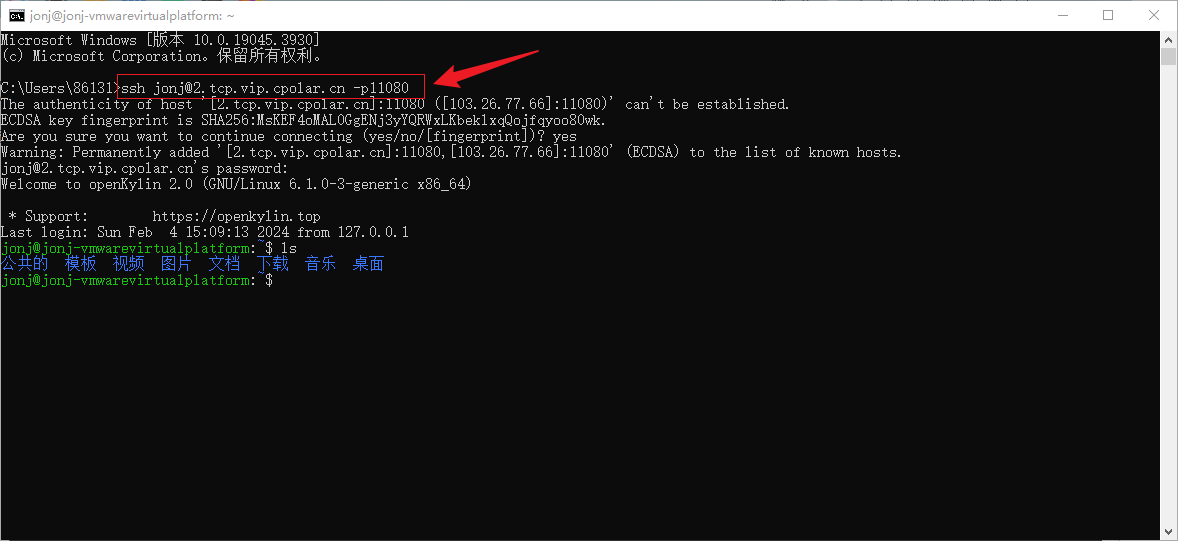充分利用每一个监听者
需要充分利用每一个消费者,需要在配置文件中加上prefetch配置并设置为1
rabbitmq:
listener:
simple:
prefetch: 1 # 每次只能获取一条消息,处理完成才能获取下一个消息
创建交换机和队列
创建队列
"fanout.queue1":队列的名称,这里是 “fanout.queue1”。false:指示队列是否是持久化的。如果设置为true,则表示队列会在 RabbitMQ 服务器重启后仍然存在。如果设置为false,则表示队列是非持久化的,即在 RabbitMQ 服务器重启后会被删除。false:指示队列是否是独占的。如果设置为true,则表示只有声明该队列的连接可以使用它。如果设置为false,则表示其他连接也可以使用该队列。true:指示队列是否会自动删除。如果设置为true,则表示当没有消费者连接到该队列时,队列会自动删除。如果设置为false,则表示队列不会自动删除。
import org.springframework.amqp.core.Queue;
import org.springframework.amqp.core.QueueBuilder;
import org.springframework.context.annotation.Bean;
import org.springframework.context.annotation.Configuration;
@Configuration
public class CreateFanoutQueue {
@Bean
public Queue fanoutQueue1() {
QueueBuilder.durable("fanout").build();
return new Queue("fanout.queue1", false, false, true);
}
}
创建交换机
name:交换机的名称。durable:指示交换机是否是持久化的。如果设置为true,则表示 RabbitMQ 服务器重启后仍然存在。如果设置为false,则表示交换机是非持久化的,即在 RabbitMQ 服务器重启后会被删除。在你的代码中,durable参数被设置为false,表示这个交换机是非持久化的。autoDelete:指示交换机是否是自动删除的。如果设置为true,则表示当没有与之绑定的队列时,交换机会自动删除。如果设置为false,则表示交换机不会自动删除。在你的代码中,autoDelete参数被设置为false,表示这个交换机不会自动删除。
@Configuration
public class CreateFanoutExchange {
/**
* 创建永久交换机,必须要设置是否自动删除
*
* @return Fanout类型交换机
*/
@Bean
public FanoutExchange fanoutExchange2() {
return new FanoutExchange("bunny.fanout2", false, false);
}
}
注解创建交换机和队列
bindings:用于定义队列和交换机之间的绑定关系。在你的代码中,通过@QueueBinding注解来定义了一个队列绑定。该绑定包括一个名为 “fanout.queue3” 的队列和一个名为 “bunny.fanout” 的交换机之间的绑定关系。value:用于指定队列的属性。在你的代码中,通过@Queue注解来指定了队列的名称为 “fanout.queue3”,并设置了durable = "true",表示该队列是持久化的。exchange:用于指定交换机的属性。在你的代码中,通过@Exchange注解来指定了交换机的名称为 “bunny.fanout”,类型为ExchangeTypes.FANOUT,并设置了durable = "true",表示该交换机是持久化的。
import lombok.extern.slf4j.Slf4j;
import org.springframework.amqp.core.ExchangeTypes;
import org.springframework.amqp.rabbit.annotation.Exchange;
import org.springframework.amqp.rabbit.annotation.Queue;
import org.springframework.amqp.rabbit.annotation.QueueBinding;
import org.springframework.amqp.rabbit.annotation.RabbitListener;
import org.springframework.stereotype.Component;
@Component
@Slf4j
public class FanoutListener {
@RabbitListener(bindings = @QueueBinding(
value = @Queue(name = "fanout.queue3", durable = "true"),
exchange = @Exchange(name = "bunny.fanout", type = ExchangeTypes.FANOUT, durable = "true")
))
public void listenFanoutQueue3(String message) {
System.out.println("消费者3接收到Fanout消息:【" + message + "】");
}
}
交换机类型与作用
- Fanout:广播,将消息交给所有绑定到交换机的队列。我们最早在控制台使用的正是 Fanout 交换机
- Direct:订阅,基于 RoutingKey(路由 key)发送给订阅了消息的队列
- Topic:通配符订阅,与 Direct 类似,只不过 RoutingKey 可以使用通配符
Fanout交换机
[!important]
- 接收publisher发送的消息
- 将消息按照规则路由到与之绑定的队列
- 不能缓存消息,路由失败,消息丢失
- FanoutExchange的会将消息路由到每个绑定的队列
无特殊功能,当队列发送消息和接受消息时,只能发送到交换机, 交换机把消息发送给绑定过的所有队列, 订阅队列的消费者都能拿到消息。
当我们给交换机绑定了三个队列,这三个队列收到消息即可完成消息监听和发送。
使用方式
- 创建两个队列,分别为
fanout.queue1和fanout.queue2

- 创建
bunny.fannout交换机。

- 绑定两个队列到交换机中。
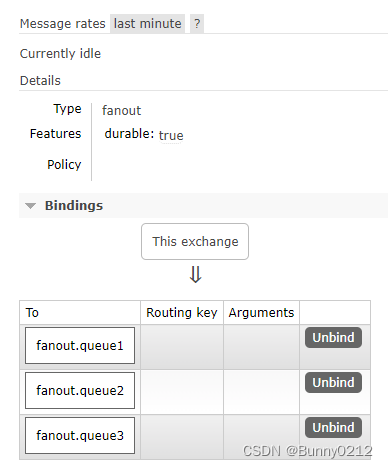
Java创建队列和交换机
import lombok.extern.slf4j.Slf4j;
import org.springframework.amqp.core.ExchangeTypes;
import org.springframework.amqp.rabbit.annotation.Exchange;
import org.springframework.amqp.rabbit.annotation.Queue;
import org.springframework.amqp.rabbit.annotation.QueueBinding;
import org.springframework.amqp.rabbit.annotation.RabbitListener;
import org.springframework.stereotype.Component;
@Component
@Slf4j
public class FanoutListener {
/**
* 监听 消费者1 是否收到消息
*
* @param message 消息
*/
@RabbitListener(queues = "fanout.queue1")
public void listenFanoutQueue1(String message) {
System.out.println("消费者1接收到Fanout消息:【" + message + "】");
}
/**
* 监听 消费者2 是否收到消息
*
* @param message 消息
*/
@RabbitListener(queues = "fanout.queue2")
public void listenFanoutQueue2(String message) {
System.out.println("消费者2接收到Fanout消息:【" + message + "】");
}
/**
* 监听 消费者2 是否收到消息
*
* @param message 消息
*/
@RabbitListener(bindings = @QueueBinding(
value = @Queue(name = "fanout.queue3", durable = "true"),
exchange = @Exchange(name = "bunny.fanout", type = ExchangeTypes.FANOUT, durable = "true")
))
public void listenFanoutQueue3(String message) {
System.out.println("消费者3接收到Fanout消息:【" + message + "】");
}
}
Java发送消息
import org.junit.jupiter.api.Test;
import org.springframework.amqp.rabbit.core.RabbitTemplate;
import org.springframework.beans.factory.annotation.Autowired;
import org.springframework.boot.test.context.SpringBootTest;
@SpringBootTest
public class TestSendFanout {
@Autowired
RabbitTemplate rabbitTemplate;
/**
* 向队列发送消息 fanout.queue1
*/
@Test
void testSendFanout1() throws Exception {
for (int i = 0; i < 100; i++) {
rabbitTemplate.convertAndSend("bunny.fanout", null, "第二个消息队列:" + i);
}
}
}
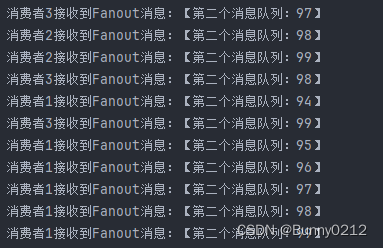
Direct交换机
使用方式
[!important]
Direct交换机与Fanout交换机的差异
- Fanout交换机将消息路由给每一个与之绑定的队列
- Direct交换机根据RoutingKey判断路由给哪个队列
- 如果多个队列具有相同的RoutingKey,则与Fanout功能类似
Direct交换机发送消息时根据路由的key来发送的,而Fanout交换机是广播发送不设置路由的key

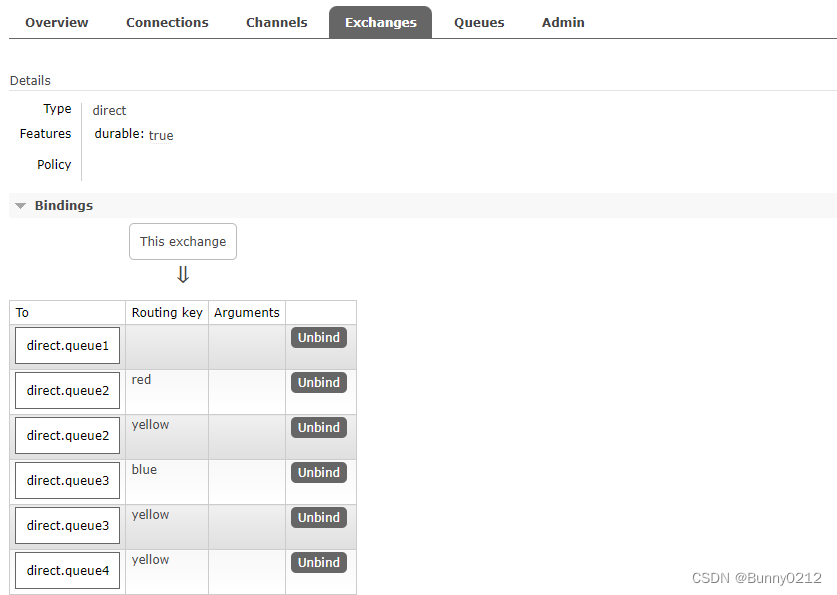
Java创建
import lombok.extern.slf4j.Slf4j;
import org.springframework.amqp.core.ExchangeTypes;
import org.springframework.amqp.rabbit.annotation.Exchange;
import org.springframework.amqp.rabbit.annotation.Queue;
import org.springframework.amqp.rabbit.annotation.QueueBinding;
import org.springframework.amqp.rabbit.annotation.RabbitListener;
import org.springframework.stereotype.Component;
@Component
@Slf4j
public class DirectListener {
/**
* * 监听者1
* 创建队列 持久化的、不自动删除
* 创建交换机 持久化的、不自动删除
* 无接受的key
*
* @param message 接受消息
*/
@RabbitListener(bindings = @QueueBinding(
value = @Queue(name = "direct.queue1", durable = "true", autoDelete = "false"),
exchange = @Exchange(name = "bunny.direct", type = ExchangeTypes.DIRECT, durable = "true", autoDelete = "false")
))
public void listenDirectQueue1(String message) {
System.out.println("消费者1接收到 Direct 消息:【" + message + "】");
}
/**
* * 监听者2
* 创建队列 持久化的、不自动删除
* 创建交换机 持久化的、不自动删除
* key包含 red 和 yellow
*
* @param message 接受消息
*/
@RabbitListener(bindings = @QueueBinding(
value = @Queue(name = "direct.queue2", durable = "true", autoDelete = "false"),
exchange = @Exchange(name = "bunny.direct", type = ExchangeTypes.DIRECT, durable = "true", autoDelete = "false"),
key = {"red", "yellow"}
))
public void listenDirectQueue2(String message) {
System.out.println("消费者2接收到 Direct key 为 {\"red\", \"yellow\"} 消息:【" + message + "】");
}
/**
* * 监听者3
* 创建队列 持久化的、不自动删除
* 创建交换机 持久化的、不自动删除
* key包含 blue 和 yellow
*
* @param message 接受消息
*/
@RabbitListener(bindings = @QueueBinding(
value = @Queue(name = "direct.queue3", durable = "true", autoDelete = "false"),
exchange = @Exchange(name = "bunny.direct", type = ExchangeTypes.DIRECT, durable = "true", autoDelete = "false"),
key = {"blue", "yellow"}
))
public void listenDirectQueue3(String message) {
System.out.println("消费者2接收到 Direct key 为 {\"blue\", \"yellow\"} 消息:【" + message + "】");
}
/**
* * 监听者4
* 创建队列 持久化的、不自动删除
* 创建交换机 持久化的、不自动删除
* key包含 yellow
*
* @param message 接受消息
*/
@RabbitListener(bindings = @QueueBinding(
value = @Queue(name = "direct.queue4", durable = "true", autoDelete = "false"),
exchange = @Exchange(name = "bunny.direct", type = ExchangeTypes.DIRECT, durable = "true", autoDelete = "false"),
key = "yellow"
))
public void listenDirectQueue4(String message) {
System.out.println("消费者2接收到 Direct key 为 \"yellow\" 消息:【" + message + "】");
}
}
Java发送消息
import org.junit.jupiter.api.Test;
import org.springframework.amqp.rabbit.core.RabbitTemplate;
import org.springframework.beans.factory.annotation.Autowired;
import org.springframework.boot.test.context.SpringBootTest;
@SpringBootTest
public class TestSendDirect {
@Autowired
RabbitTemplate rabbitTemplate;
/**
* 发送黄色消息
*/
@Test
void testSendDirectYellow() throws Exception {
for (int i = 0; i < 1000; i++) {
rabbitTemplate.convertAndSend("bunny.direct", "yellow", "发送消息:" + i);
}
}
/**
* 发送红色消息
*/
@Test
void testSendDirectRed() throws Exception {
for (int i = 0; i < 1000; i++) {
rabbitTemplate.convertAndSend("bunny.direct", "red", "发送消息:" + i);
}
}
/**
* 发送蓝色消息
*/
@Test
void testSendDirectBlue() throws Exception {
for (int i = 0; i < 1000; i++) {
rabbitTemplate.convertAndSend("bunny.direct", "blue", "发送消息:" + i);
}
}
}
由于消费者1没有绑定任何key所以任何消息都没有接受到。
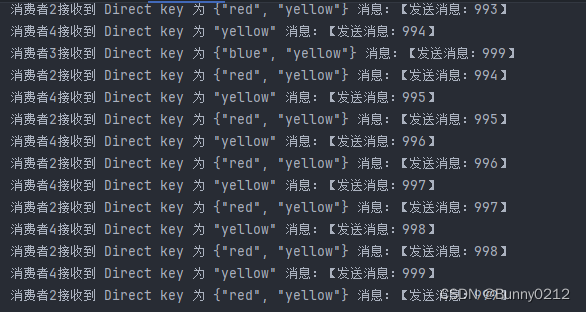
Topic交换机
使用方式
[!important]
Direct交换机与Topic交换机的差异?
- Topic交换机接收的消息RoutingKey必须是多个单词,以
**.**分割- Topic交换机与队列绑定时的bindingKey可以指定通配符
#:代表0个或多个词*:代表1个词

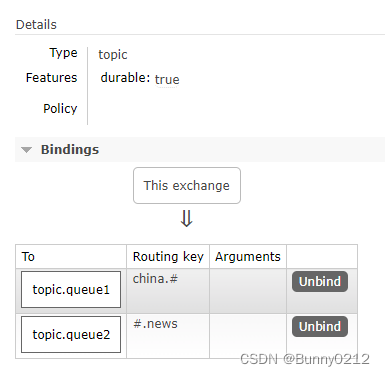
Java创建
import lombok.extern.slf4j.Slf4j;
import org.springframework.amqp.core.ExchangeTypes;
import org.springframework.amqp.rabbit.annotation.Exchange;
import org.springframework.amqp.rabbit.annotation.Queue;
import org.springframework.amqp.rabbit.annotation.QueueBinding;
import org.springframework.amqp.rabbit.annotation.RabbitListener;
import org.springframework.stereotype.Component;
@Component
@Slf4j
public class TopicListener {
/**
* * 监听者1
* 创建队列 持久化的、不自动删除
* 创建交换机 持久化的、不自动删除
* key为china.#
*
* @param message 接受消息
*/
@RabbitListener(bindings = @QueueBinding(
value = @Queue(name = "topic.queue1"),
exchange = @Exchange(name = "bunny.topic", type = ExchangeTypes.TOPIC),
key = "china.#"
))
public void listenTopicChina(String message) {
System.out.println("消费者1接收到topic.queue1的消息:【" + message + "】");
}
/**
* * 监听者1
* 创建队列 持久化的、不自动删除
* 创建交换机 持久化的、不自动删除
* #.news
*
* @param message 接受消息
*/
@RabbitListener(bindings = @QueueBinding(
value = @Queue(name = "topic.queue2"),
exchange = @Exchange(name = "bunny.topic", type = ExchangeTypes.TOPIC),
key = "#.news"
))
public void listenTopicNews(String message) {
System.out.println("消费者1接收到topic.queue2的消息:【" + message + "】");
}
}
Java发送消息
import org.junit.jupiter.api.Test;
import org.springframework.amqp.rabbit.core.RabbitTemplate;
import org.springframework.beans.factory.annotation.Autowired;
import org.springframework.boot.test.context.SpringBootTest;
@SpringBootTest
public class TestSendTopic {
@Autowired
RabbitTemplate rabbitTemplate;
/**
* 发送消息 key 包含 china.# 的
*/
@Test
void testSendTopic1() throws Exception {
for (int i = 0; i < 1000; i++) {
rabbitTemplate.convertAndSend("bunny.topic", "china.ly", "china.ly 发送消息:" + i);
}
}
/**
* 发送消息 key 包含 #.news 的
*/
@Test
void testSendTopic2() {
for (int i = 0; i < 1000; i++) {
rabbitTemplate.convertAndSend("bunny.topic", "ly.news", "ly.news 发送消息:" + i);
}
}
}

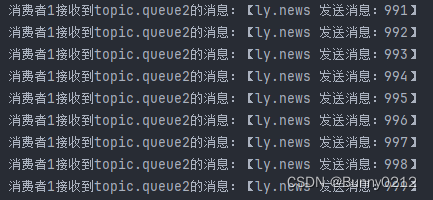
消息持久化
为了提升性能,默认情况下MQ的数据都是在内存存储的临时数据,重启后就会消失。为了保证数据的可靠性,必须配置数据持久化,包括:
- 交换机持久化(在交换机类型与作用已解释)
- 队列持久化(在交换机类型与作用已解释)
- 消息持久化(本文介绍)
使用MessageBuilder创建使用调用方法setDeliveryMode,在里面设置持久化消息和非持久化消息
非持久化消息
setDeliveryMode(MessageDeliveryMode.NON_PERSISTENT)设置非持久化消息。
import org.junit.jupiter.api.Test;
import org.springframework.amqp.core.Message;
import org.springframework.amqp.core.MessageBuilder;
import org.springframework.amqp.core.MessageDeliveryMode;
import org.springframework.amqp.rabbit.core.RabbitTemplate;
import org.springframework.beans.factory.annotation.Autowired;
import org.springframework.boot.test.context.SpringBootTest;
import java.nio.charset.StandardCharsets;
@SpringBootTest
public class TestSendFanout {
@Autowired
RabbitTemplate rabbitTemplate;
/**
* * 发送数据非持久化
* 向 bunny.fanout 发送消息
*/
@Test
void testSendFanout2() throws Exception {
// 创建消息-非持久化消息
Message message = MessageBuilder.withBody("hello world".getBytes(StandardCharsets.UTF_8))
.setDeliveryMode(MessageDeliveryMode.NON_PERSISTENT).build();
// 发送很多消息
for (int i = 0; i < 1000000; i++) {
rabbitTemplate.convertAndSend("bunny.fanout", null, message);
}
}
}
持久化消息
setDeliveryMode(MessageDeliveryMode.PERSISTENT)设置持久化消息。
import org.junit.jupiter.api.Test;
import org.springframework.amqp.core.Message;
import org.springframework.amqp.core.MessageBuilder;
import org.springframework.amqp.core.MessageDeliveryMode;
import org.springframework.amqp.rabbit.core.RabbitTemplate;
import org.springframework.beans.factory.annotation.Autowired;
import org.springframework.boot.test.context.SpringBootTest;
import java.nio.charset.StandardCharsets;
@SpringBootTest
public class TestSendFanout {
@Autowired
RabbitTemplate rabbitTemplate;
@Test
void testSendFanout3() throws Exception {
// 创建消息-持久化消息
Message message = MessageBuilder
.withBody("hello".getBytes(StandardCharsets.UTF_8))
.setDeliveryMode(MessageDeliveryMode.PERSISTENT)
.build();
// 发送很多消息
for (int i = 0; i < 1000000; i++) {
rabbitTemplate.convertAndSend("bunny.fanout", null, message);
}
}
}
惰性队列
惰性队列比其它队列性能好,速度快。
控制台操作
使用控制台添加惰性队列。
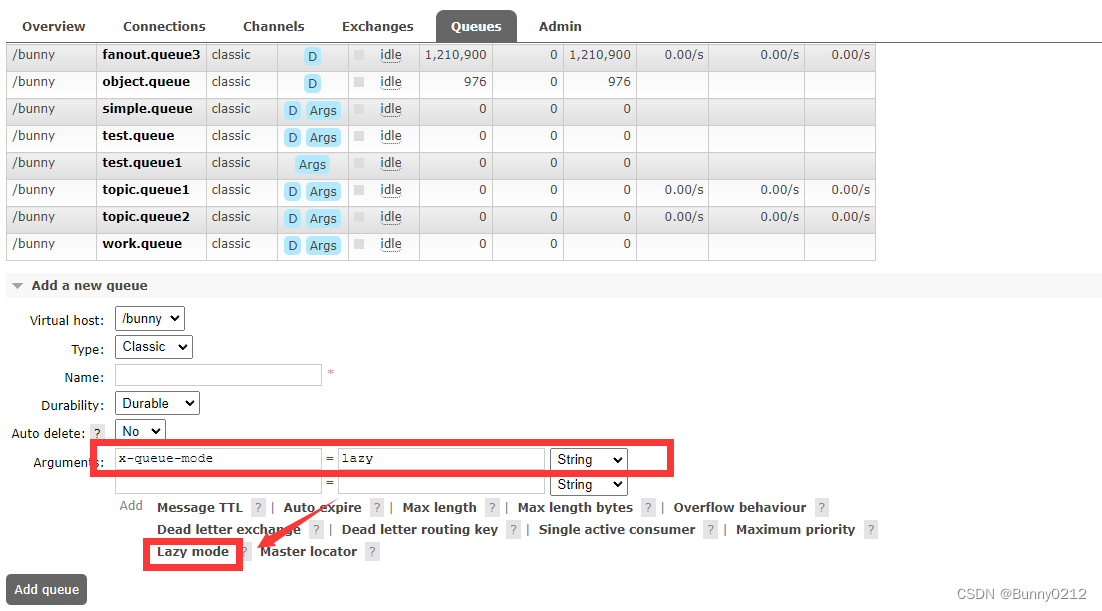
Java方式添加
不基于注解
使用IOC容器注入,使用属性名方式lazy()创建。
@Configuration
public class CreateLazyQueue {
/**
* 创建惰性队列
*
* @return 惰性队列
*/
@Bean
public Queue lazyQueue() {
return QueueBuilder.durable("lazy.queue1").lazy().build();
}
}
基于注解
也是比较常见的方式,这种也方便。
@Queue(name = "lazy.queue2", durable = "true", autoDelete = "false", arguments = @Argument(name = "x-queue-mode", value = "lazy"))
全部代码
import lombok.extern.slf4j.Slf4j; import org.springframework.amqp.core.ExchangeTypes; import org.springframework.amqp.rabbit.annotation.*; import org.springframework.stereotype.Component; @Component @Slf4j public class LazyListener { @RabbitListener(bindings = @QueueBinding( value = @Queue(name = "lazy.queue2", durable = "true", autoDelete = "false", arguments = @Argument(name = "x-queue-mode", value = "lazy")), exchange = @Exchange(name = "lazy.fanout", type = ExchangeTypes.FANOUT, durable = "true", autoDelete = "false") )) public void listenLazyQueue1(String message) { System.out.println("消费者1接收到 Lazy 消息:【" + message + "】"); } }
更新已有队列为lazy模式
对于已经存在的队列,也可以配置为lazy模式,但是要通过设置policy实现。
命令行方式
可以基于命令行设置policy
命令解读:
rabbitmqctl:RabbitMQ的命令行工具set_policy:添加一个策略Lazy:策略名称,可以自定义"^lazy-queue$":用正则表达式匹配队列的名字'{"queue-mode":"lazy"}':设置队列模式为lazy模式--apply-to queues:策略的作用对象,是所有的队列
rabbitmqctl set_policy Lazy "^lazy-queue$" '{"queue-mode":"lazy"}' --apply-to queues
控制台方式
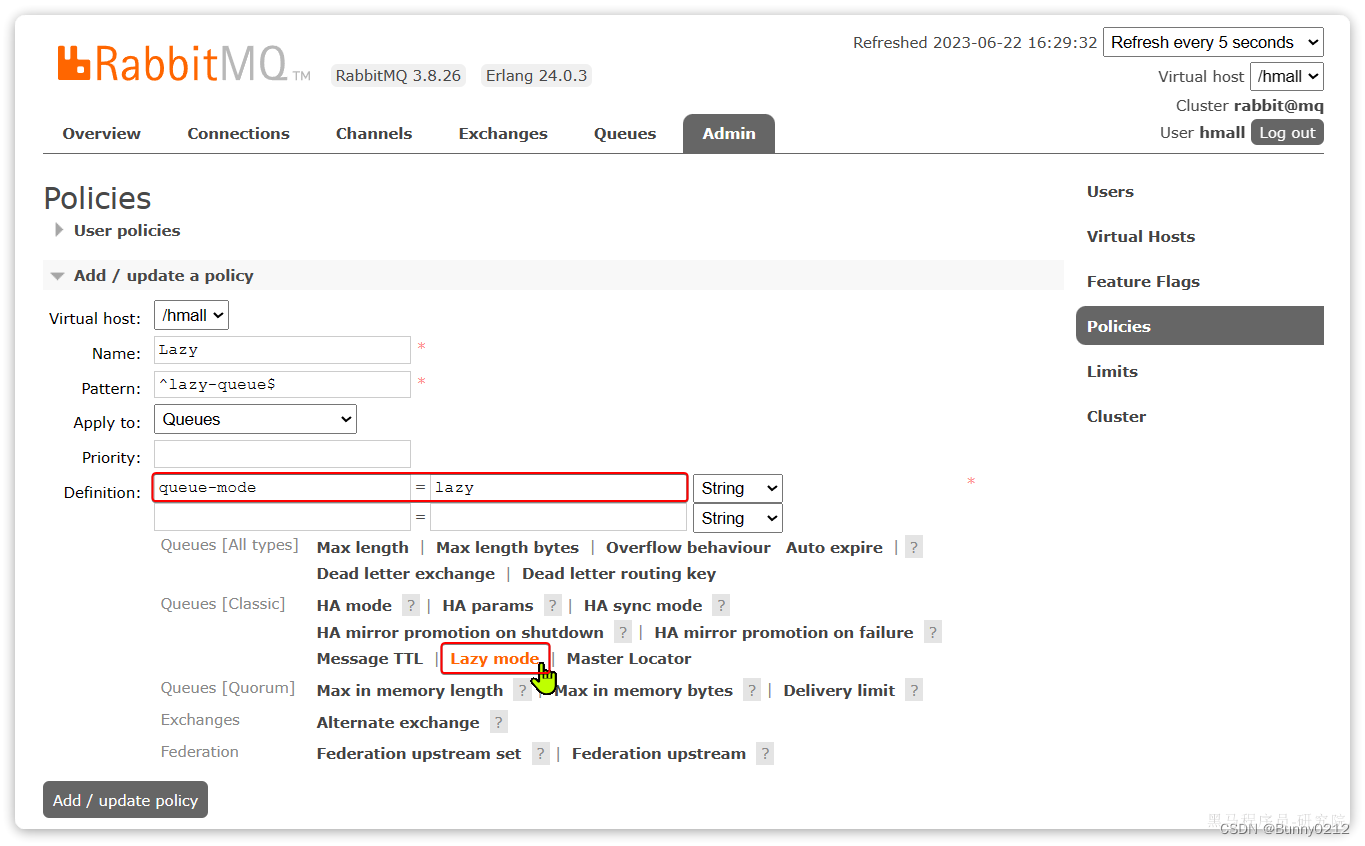
消费者的可靠性
[!tip]
当RabbitMQ向消费者投递消息以后,需要知道消费者的处理状态如何。因为消息投递给消费者并不代表就一定被正确消费了,可能出现的故障有很多,比如:
- 消息投递的过程中出现了网络故障
- 消费者接收到消息后突然宕机
- 消费者接收到消息后,因处理不当导致异常
失败重试机制
当消费者出现异常后,消息会不断requeue(重入队)到队列,再重新发送给消费者。如果消费者再次执行依然出错,消息会再次requeue到队列,再次投递,直到消息处理成功为止。
极端情况就是消费者一直无法执行成功,那么消息requeue就会无限循环,导致mq的消息处理飙升,带来不必要的压力
spring:
rabbitmq:
listener:
simple:
retry:
enabled: true # 开启消费者失败重试
initial-interval: 1000ms # 初识的失败等待时长为1秒
multiplier: 1 # 失败的等待时长倍数,下次等待时长 = multiplier * last-interval
max-attempts: 3 # 最大重试次数
stateless: true # true无状态;false有状态。如果业务中包含事务,这里改为false
Java中配置
当消息中出现异常时,自动转到错误交换机和错误队列中,方便开发和调试人员查看。
创建error.direct,设置key为error,队列为error.queue。
当然,如果在配置中没有设置错误机制这时某些配置也没有必要加载进来,当配置spring.rabbitmq.listener.simple.retry.enabled为true时才启用当前配置。
@ConditionalOnProperty(name = "spring.rabbitmq.listener.simple.retry.enabled", havingValue = "true")// 当开启错误重试这个配置才有效果
示例代码
import lombok.extern.slf4j.Slf4j;
import org.springframework.amqp.core.Binding;
import org.springframework.amqp.core.BindingBuilder;
import org.springframework.amqp.core.DirectExchange;
import org.springframework.amqp.core.Queue;
import org.springframework.amqp.rabbit.core.RabbitTemplate;
import org.springframework.amqp.rabbit.retry.MessageRecoverer;
import org.springframework.amqp.rabbit.retry.RepublishMessageRecoverer;
import org.springframework.boot.autoconfigure.condition.ConditionalOnProperty;
import org.springframework.context.annotation.Bean;
import org.springframework.context.annotation.Configuration;
@Configuration
@ConditionalOnProperty(name = "spring.rabbitmq.listener.simple.retry.enabled", havingValue = "true")// 当开启错误重试这个配置才有效果
@Slf4j
public class ErrorConfiguration {
@Bean
public MessageRecoverer republishMessageRecoverer(RabbitTemplate rabbitTemplate) {
log.info("加载错误交换机");
return new RepublishMessageRecoverer(rabbitTemplate, "error.direct", "error");
}
}
只查看不做处理
如果只是想在MQ控制台中查看错误消息,并不需要监听错误消息,这时可以使用之前IOC注入方式配置。
创建交换机、队列,之后绑定设置需要传入的key。
import lombok.extern.slf4j.Slf4j;
import org.springframework.amqp.core.Binding;
import org.springframework.amqp.core.BindingBuilder;
import org.springframework.amqp.core.DirectExchange;
import org.springframework.amqp.core.Queue;
import org.springframework.amqp.rabbit.core.RabbitTemplate;
import org.springframework.amqp.rabbit.retry.MessageRecoverer;
import org.springframework.amqp.rabbit.retry.RepublishMessageRecoverer;
import org.springframework.boot.autoconfigure.condition.ConditionalOnProperty;
import org.springframework.context.annotation.Bean;
import org.springframework.context.annotation.Configuration;
@Configuration
@ConditionalOnProperty(name = "spring.rabbitmq.listener.simple.retry.enabled", havingValue = "true")// 当开启错误重试这个配置才有效果
@Slf4j
public class ErrorConfiguration {
@Bean
public DirectExchange errorMessageExchange() {
return new DirectExchange("error.direct");
}
@Bean
public Queue errorQueue() {
return new Queue("error.queue", true);
}
@Bean
public Binding errorBinding(Queue errorQueue, DirectExchange errorMessageExchange) {
return BindingBuilder.bind(errorQueue).to(errorMessageExchange).with("error");
}
@Bean
public MessageRecoverer republishMessageRecoverer(RabbitTemplate rabbitTemplate) {
log.info("加载错误交换机");
return new RepublishMessageRecoverer(rabbitTemplate, "error.direct", "error");
}
}
测试配置
为了验证我们配置的是否有问题,可以在监听消息时手动抛出异常。
对消息进行错误测试,在消息中抛出异常。
/**
* * 监听者3
* 创建队列 持久化的、不自动删除
* 创建交换机 持久化的、不自动删除
* key包含 blue 和 yellow
*
* @param message 接受消息
*/
@RabbitListener(bindings = @QueueBinding(
value = @Queue(name = "direct.queue3", durable = "true", autoDelete = "false"),
exchange = @Exchange(name = "bunny.direct", type = ExchangeTypes.DIRECT, durable = "true", autoDelete = "false"),
key = {"blue", "yellow"}
))
public void listenDirectQueue3(String message) {
System.out.println("消费者3接收到 Direct key 为 {\"blue\", \"yellow\"} 消息:【" + message + "】");
throw new RuntimeException("错误消息");
}
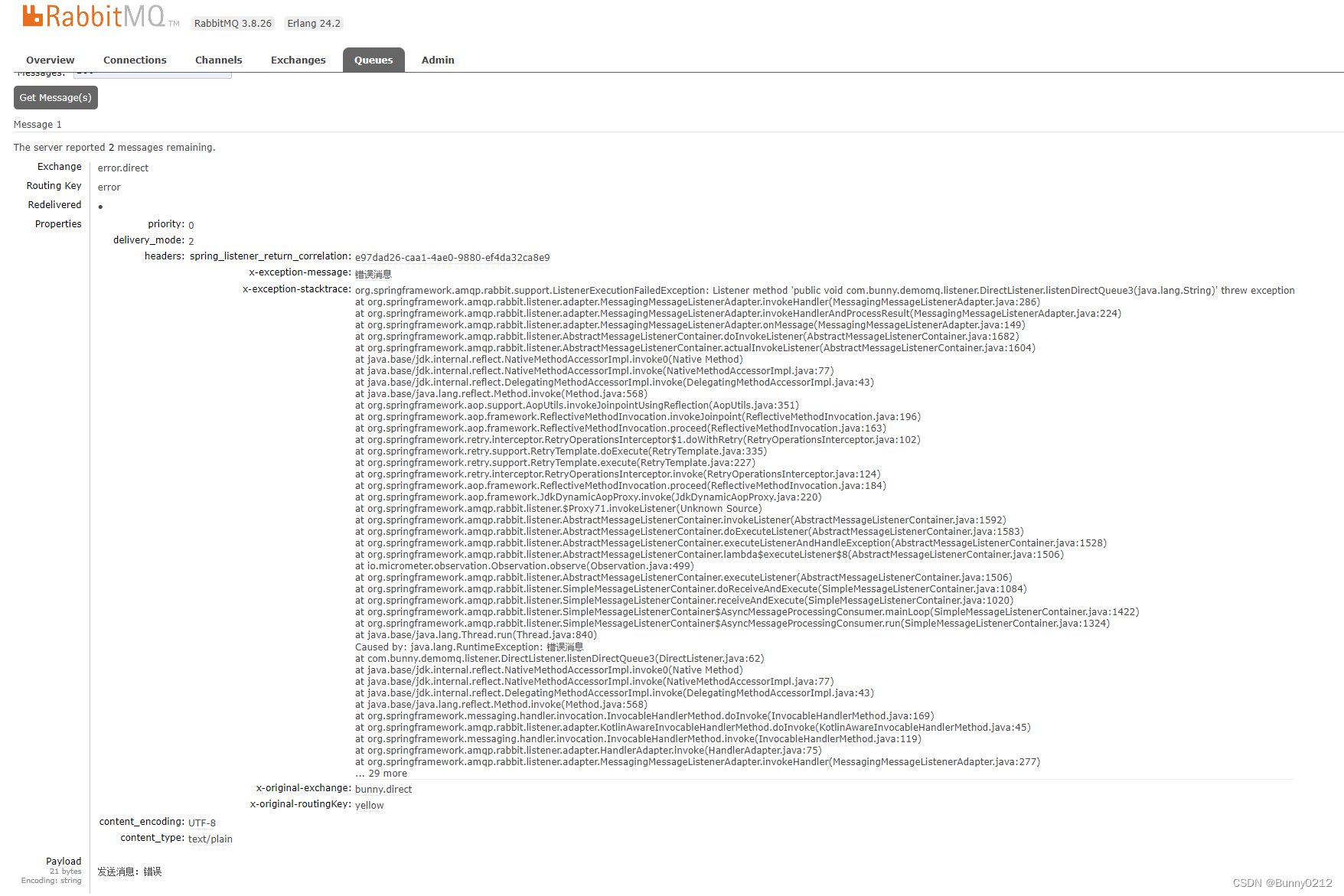
对消息进行监听处理
如果需要对错误队列进行监听并且做出相应处理,使用注解方式,可以直接创建并监听消息。
其中自动绑定了消息队列,和自动创建了错误交换机。
import lombok.extern.slf4j.Slf4j;
import org.springframework.amqp.core.ExchangeTypes;
import org.springframework.amqp.rabbit.annotation.Exchange;
import org.springframework.amqp.rabbit.annotation.Queue;
import org.springframework.amqp.rabbit.annotation.QueueBinding;
import org.springframework.amqp.rabbit.annotation.RabbitListener;
import org.springframework.stereotype.Component;
import java.time.LocalDateTime;
@Component
@Slf4j
public class ErrorListener {
@RabbitListener(bindings = @QueueBinding(
value = @Queue(name = "error.queue", durable = "true"),
exchange = @Exchange(name = "error.direct", type = ExchangeTypes.DIRECT),
key = "error"
))
@RabbitListener(queues = "error.queue")
public void listenError(String message) {
System.out.println(LocalDateTime.now() + "收集错误队列-消费者接收到 error 消息:【" + message + "】");
}
}

全部的配置
spring:
application:
name: demo-mq
rabbitmq:
host: 192.168.1.6 # 主机地址
port: 5672 # 端口
virtual-host: /bunny # 虚拟主机
username: bunny # 用户名
password: "02120212" # 密码
listener:
simple:
prefetch: 1 # 每次只能获取一条消息,处理完成才能获取下一个消息
acknowledge-mode: auto # 确认机制
retry:
enabled: true # 开启消费者失败重试
initial-interval: 1000ms # 初始失败等待时长
multiplier: 1 # 下次失败等待时间被树,下次等待时长 multiplier * last-interval
max-attempts: 3 # 最大重试次数
stateless: true # true 无状态 false 有状态。如果业务中包含事务,这里改为false
connection-timeout: 1s # 设置mq连接超时时间
template:
retry:
enabled: true # 开启超时重试机制
initial-interval: 200ms # 失败后初始等待时间
multiplier: 1 # 失败后下次等待时长倍数,发送消息失败不会走这个
max-attempts: 3 # 最大重试次数
publisher-confirm-type: none # 开启publisher confirm机制,并设置confirm类型
publisher-returns: true # 开启publisher return机制
业务幂等性
什么事幂等性
幂等是一个数学概念,用函数表达式来描述是这样的:f(x) = f(f(x)),例如求绝对值函数。 在程序开发中,则是指同一个业务,执行一次或多次对业务状态的影响是一致的。例如:
- 根据id删除数据
- 查询数据
- 新增数据
但数据的更新往往不是幂等的,如果重复执行可能造成不一样的后果。比如:
- 取消订单,恢复库存的业务。如果多次恢复就会出现库存重复增加的情况
- 退款业务。重复退款对商家而言会有经济损失。
所以,我们要尽可能避免业务被重复执行。 然而在实际业务场景中,由于意外经常会出现业务被重复执行的情况,例如:
- 页面卡顿时频繁刷新导致表单重复提交
- 服务间调用的重试
- MQ消息的重复投递
生成消息唯一ID
SpringAMQP的MessageConverter自带了MessageID的功能,我们只要开启这个功能即可。 以Jackson的消息转换器为例:
@Bean
public MessageConverter messageConverter(){
// 1.定义消息转换器
Jackson2JsonMessageConverter jjmc = new Jackson2JsonMessageConverter();
// 2.配置自动创建消息id,用于识别不同消息,也可以在业务中基于ID判断是否是重复消息
jjmc.setCreateMessageIds(true);
return jjmc;
}
延迟消息
对于超过一定时间未支付的订单,应该立刻取消订单并释放占用的库存。
像这种在一段时间以后才执行的任务,我们称之为延迟任务,而要实现延迟任务,最简单的方案就是利用MQ的延迟消息了。
在RabbitMQ中实现延迟消息也有两种方案:
- 死信交换机+TTL
- 延迟消息插件
基于死信队列虽然可以实现延迟消息,但是太麻烦了。因此RabbitMQ社区提供了一个延迟消息插件来实现相同的效果。
DelayExchange插件
官方文档说明
Scheduling Messages with RabbitMQ | RabbitMQ - Blog
插件下载地址
GitHub - rabbitmq/rabbitmq-delayed-message-exchange: Delayed Messaging for RabbitMQ
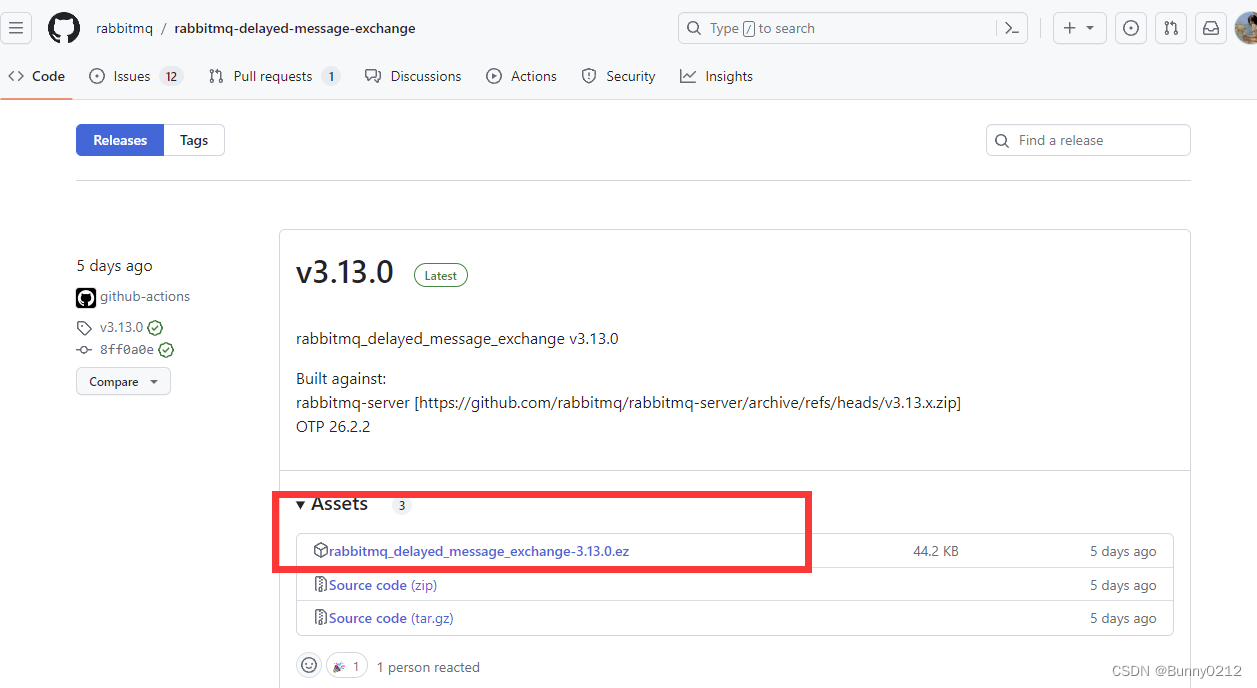
安装延迟插件
找到RabbitMQ镜像插件位置。
docker inspect mq
# 或者执行
docker volume inspect mq-plugins
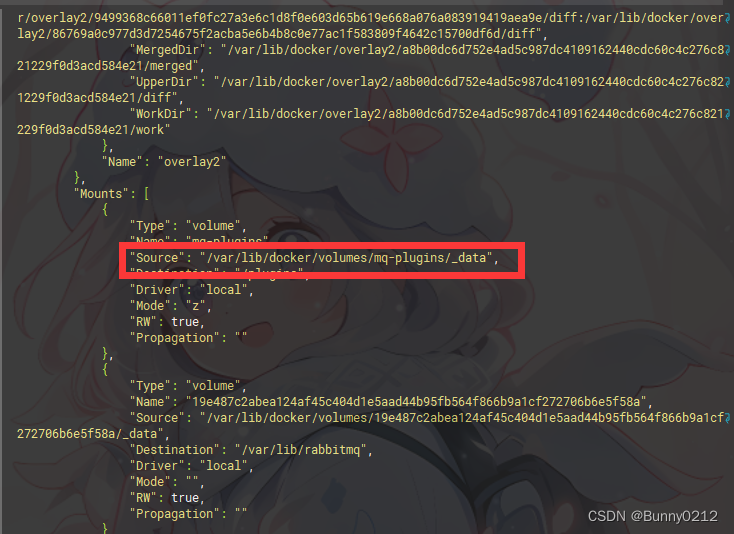
将插件拖入rabbitmq_delayed_message_exchange-3.8.17.8f537ac.ez

执行命令
rabbitmq_delayed_message_exchange是你的插件名称。
docker exec -it mq rabbitmq-plugins enable rabbitmq_delayed_message_exchange
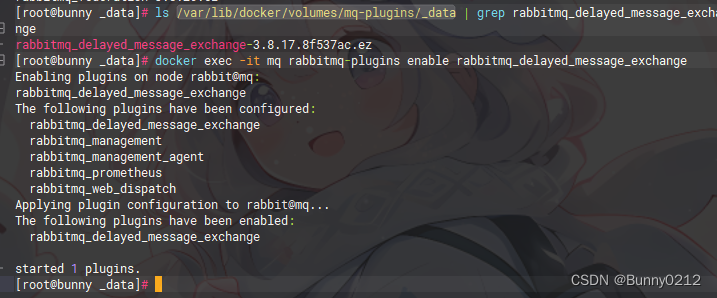
Java中使用
创建延迟消息,延迟消息如果很多而且延迟时间较长不建议使用MQ去处理这些消息,因为在内部会维护一个时钟,如果消息很大时间又长,对于系统资源消耗会很大。
如果时间很长可以使用Redis去处理这些内容。
不基于注解
使IOC容器方式创建延迟消息。
import lombok.extern.slf4j.Slf4j;
import org.springframework.amqp.core.DirectExchange;
import org.springframework.amqp.core.ExchangeBuilder;
import org.springframework.context.annotation.Bean;
import org.springframework.context.annotation.Configuration;
@Configuration
@Slf4j
public class CreateDirectExchange {
/**
* 创建延迟交换机
*
* @return 延迟交换机
*/
@Bean
public DirectExchange delayExchange() {
return ExchangeBuilder.directExchange("delay.direct")
.delayed()// 设置delay的属性为true
.durable(true)// 持久化
.build();
}
}
基于注解
使用注解方式一次性创建交换机、队列、延迟消息。
import lombok.extern.slf4j.Slf4j;
import org.springframework.amqp.rabbit.annotation.Exchange;
import org.springframework.amqp.rabbit.annotation.Queue;
import org.springframework.amqp.rabbit.annotation.QueueBinding;
import org.springframework.amqp.rabbit.annotation.RabbitListener;
import org.springframework.stereotype.Component;
@Component
@Slf4j
public class DelayListener {
@RabbitListener(bindings = @QueueBinding(
value = @Queue(name = "delay.queue", durable = "true"),
exchange = @Exchange(name = "delay.direct", delayed = "true"),
key = "delay"
))
public void listenDelay(String message) {
System.out.println("消费者接收到 delay 消息:【" + message + "】");
}
}
创建延迟消息会有独特的tag。

创建队列

发送延迟消息
import lombok.extern.slf4j.Slf4j;
import org.junit.jupiter.api.Test;
import org.springframework.amqp.rabbit.core.RabbitTemplate;
import org.springframework.beans.factory.annotation.Autowired;
import org.springframework.boot.test.context.SpringBootTest;
@SpringBootTest
@Slf4j
public class TestSendDelay {
@Autowired
RabbitTemplate rabbitTemplate;
@Test
void testSendDelay() throws Exception {
rabbitTemplate.convertAndSend("delay.direct", "delay", "延迟消息", message -> {
message.getMessageProperties().setDelayLong(5000L);
return message;
});
log.info("延迟消息发送成功");
}
}

